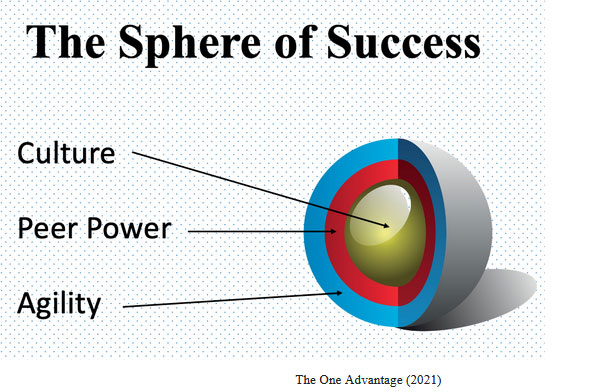Sphere of Success and The Future of Work (Part 5)

In the first article of my Future of Work series, I offered a quote from Thomas Jefferson that speaks to what organizational leaders need to do to survive and thrive in a fast-changing world over the next decade. “In matters of style, swim with the current; in matters of principle, stand like a rock.” In short, your future of work depends on a relentless commitment to creating organizational agility while at the same time rededicating yourself to your purpose and core values. This yin and yang will serve as the foundation for developing an adaptive culture and meeting the demands of an uncertain future.
Deloitte describes adaptative organizations as “able to quickly detect shifts in the external environment, and flex appropriately. In spite of constant iteration and adaption, a shared purpose is the glue that anchors an ecosystem.” Of course, knowing what to do is one thing, understanding how to do it is quite another. Here’s a 3-dimensional illustration for building an adaptive organization.
Culture
As you would imagine, culture is at the core. In a new book, Culture Ignited: 5 Disciplines for Adaptive Leaders, author and founder of Ideal Outcomes, Inc., Jason Richmond wrote:
“Companies with a healthy culture thrive because they create the sense that everyone is in it together. Those companies also care about more than the bottom line. Making a profit is essential, certainly, but purpose is what drives commitment and passion. Purpose is what differentiates you to your customers, vendors, employees, and potential employees.
The flourishing businesses will be those whose leaders recognize that purpose drives profits and profits sustain purpose. They go hand in hand.”
Values, priorities, traits, and behaviors drive an organization’s shared purpose. They bring authenticity and meaning to the organization’s value proposition (why it exists). The fact that it is “shared” is essential. “Shared” doesn’t mean simply complying with the leadership’s concept of organizational purpose. It involves having leaders who are willing to invite and enlist the entire team to create and finetune it, thus clarifying and creating ownership of the values and behaviors that will help it thrive. When purpose and values are shared, they drive profits, partly because they guide decision-making at every level, resulting in an organization that is more steadfast, trustworthy, and agile.
Peer Power
Too many organizations are set up with the leadership on one side of the table and the employees on the other, creating a blame culture versus one of learning and growing. Accessing and leveraging an organization’s peer power provides an overlapping and reinforcing dynamic that strengthens culture from the inside. Doing so also builds institutional muscles for detecting shifts in the external environment, allowing it to flex as needed to maximize opportunities and meet challenges from the outside. A culture where everyone is in it together is an indomitable force. Here’s what having everyone on the same team looks like:
Anchored by purpose and values, the leader, the team, and the individual team member enjoy a shared responsibility for learning, growing, and being more productive and agile – the critical ingredients to building an adaptive organization. What’s more, team members don’t bring their best selves every day to impress their supervisors or to achieve KPIs; they do so because their currency with one another rests with bringing their best. They win and learn as one. It’s a common thread for the very best teams globally, whether it’s in sports, the military, or in business.
Peernovation’s Five-Factor Framework intentionally unlocks peer power and inspires more effective collaboration. It assures that the organization has the right people, experiences psychological safety, maximizes productivity, embraces peer-to-peer accountability, and enjoys the value of a servant leader who is a part of the team, never apart from it.
Agility
Jason Richmond writes, “An emphasis on collaboration is essential for organizations to build employee and company resilience in a constantly changing world. Collaboration is the foundation for knowledge transfer and the ability to flex employee skills, deploying them where they are needed and most effective.”
Organizational agility expert Mike Richardson states that most organizations have an agility gap, which he defines as the growing gulf between the demands on our agility and the supply of agility required to meet the demand. With the demand going up and the supply remaining constant, chaos fills the gap. It’s detrimental to our organizations and even more so for us as individuals both in business and in life.
Richardson says that agility is not simply about responding effectively to the unexpected; it’s about proactively anticipating and preparing for what’s next. Doing so will require focusing on culture (shared purpose and values), peer power (improved clarity and collaboration), and being more intentional about fostering agility.
Building an Adaptive Organization
“Leaders have seen that truly agile operating models can deliver meaningful business gains. Total clarity on priorities and goals, nimble resource allocation, and reduced handovers can boost productivity by 20 to 40 percent. A genuine customer orientation with fast, iterative feedback cycles can raise customer-satisfaction scores by 30 points. And people working with a clearer purpose and greater autonomy to make decisions will drive up employee-engagement scores” (McKinsey, December 2020).
That said, you build an organization from the inside out. The Sphere of Success (illustrating the 360° nature of the challenge) offers a model that starts with culture, culminates in agility, and is held together by a team of people who are all in it together. Unlocking the peer power in your organization will help you create a purpose-driven culture and a workforce which is ready, willing, and able to face anything that comes its way from the outside. As your team continues to learn and grow, it will help its members swim with the current and stand like a rock to everyone’s benefit.
Previous articles from The Future of Work series:
- The Future of Work: You Don’t Need a Plan. You Need a Commitment.
- Inclusive Leadership and The Future of Work
- Inclusive Leadership and The Future of Work (Part 2)
- Four Rules of Accountability in a New World
Add CEOWORLD magazine to your Google News feed.
Follow CEOWORLD magazine headlines on: Google News, LinkedIn, Twitter, and Facebook.
Copyright 2024 The CEOWORLD magazine. All rights reserved. This material (and any extract from it) must not be copied, redistributed or placed on any website, without CEOWORLD magazine' prior written consent. For media queries, please contact: info@ceoworld.biz










